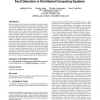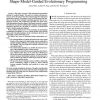1191 search results - page 238 / 239 » INSPIRE: A New Method of Mapping Information Spaces |
AAAI
2010
13 years 7 months ago
2010
g Without a Heuristic: Efficient Use of Abstraction Bradford Larsen, Ethan Burns, Wheeler Ruml Department of Computer Science University of New Hampshire Durham, NH 03824 USA blars...
SAC
2006
ACM
13 years 5 months ago
2006
ACM
Fast and accurate fault detection is becoming an essential component of management software for mission critical systems. A good fault detector makes possible to initiate repair a...
TMI
2002
13 years 5 months ago
2002
This paper presents a fully automated segmentation method for medical images. The goal is to localize and parameterize a variety of types of structure in these images for subsequen...
PRL
2010
13 years 4 months ago
2010
: Single training image face recognition is one of main challenges to appearance-based pattern recognition techniques. Many classical dimensionality reduction methods such as LDA h...
JMLR
2011
13 years 22 days ago
2011
We propose a framework MIC (Multiple Inclusion Criterion) for learning sparse models based on the information theoretic Minimum Description Length (MDL) principle. MIC provides an...


